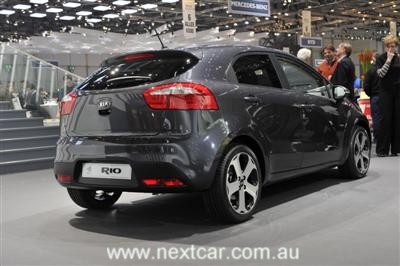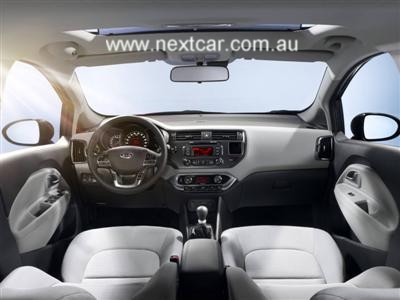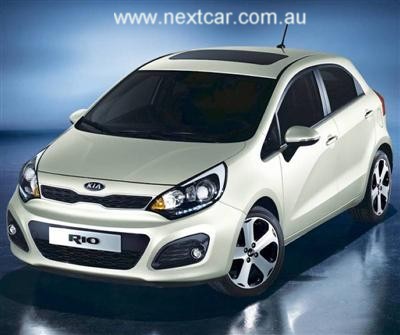Next Kia Rio revealed
|


 The new Kia Rio release dates for the Australian market:
The new Kia Rio release dates for the Australian market:
5 door hatchback - 3rd quarter 2011
4 door sedan - 4th quarter 2011
3 door hatchback - 1st quarter 2012
|
|
|
Home >
News >
Kia
3rd March, 2011
- CO2 emissions for Rio model range start from an industry-leading 85 g/km
- Wide variety of trim options
Kia’s fourth-generation Rio, revealed at the 2011 Geneva Motor Show (3rd-13th March), boasts a
bold and distinctive 'personality', bringing the latest model into line with the rest of Kia’s
striking design-led product range.
In addition to appealing to consumers’ aesthetic tastes, the new Kia Rio will spearhead the
company’s efforts to significantly grow its market share across the globe by offering potential
owners industry-leading environmental credentials.
Target CO2 emissions for the model range start at just 85 g/km – representing a new
industry-wide low. This impressive figure places the B-segment Rio ahead of all other models in
its class and, according to Kia, all vehicles currently on sale in the entire European market.
Tasked with the difficult job of improving upon the remarkable international sales success of
the previous generation model, Kia’s engineers and designers have developed a new Rio which
combines European finesse with Korean spice to make a form language that also communicates Latin
flair, for global appeal.
“The Kia Rio has always been successful, and with this new 'incarnation' we have a car
which is extremely attractive with a fresh feeling of sportiness – a car that people will want to
buy for its looks, as well as its environmental credentials” comments Benny Oeyen,
Vice-President Marketing and Product Planning, Kia Motors Europe.
Since its launch in 2005, global sales of the third-generation Rio have totalled more than
860,000 units. It was the company’s third best-selling vehicle in overseas markets during 2010
with sales of more than 219,000 units.
The new Rio model is longer (by 20 mm), wider (by 25 mm), and lower (by 15 mm) and features a
wheelbase extended by 70 mm (to 2,570 mm) – greatly enhancing passenger space and cargo capacity.
With an overall height of 1,455 mm, new Rio is one of the lowest cars in Kia’s European product
range.
Manufactured for the first time with a choice of 5-door and 3-door bodystyles in Europe -
Australia will also get a sedan version - new Rio is set to completely redefine its position as
one of the most competitive vehicles in one of the most competitive sectors – the B-segment.
Kia’s market research predicts that global demand for B-segment cars is going to grow
significantly over the next two years.
With two body styles for sporty new Rio – plus the already popular Soul and Venga models
appealing to people who want to stand out from the crowd or need a spacious and versatile
compact MPV – Kia is confident of capturing a larger share of this growing market segment.
To lower fuel consumption and help achieve Rio’s class-leading emissions, Kia engineers
have carried out an extensive programme to shed weight across a broad range of components. As
a result, although new Rio is a significantly larger car than the third-generation model with
extra equipment, its weight-gain has been kept to a minimum.
The 5-door version of new Rio is expected to be on sale in Australia in the third quarter
of 2011 with the sedan late in the year and the 3-door joining the line-up early in 2012.
All models will be manufactured at Kia’s Sohari plant in Korea.
‘Premium presence’ for compact new car
With new Rio, Kia has made a car that answers consumer demand for more quality, more choice,
and attractive, exciting design.
This new car is no evolution of its predecessor, it is a revolution. The bold and distinctive
'personality' of the new Rio represents a complete departure from its predecessor and fits
perfectly into the revitalised new family of Kia products.
Viewed head on, new Rio has its own unique interpretation of the Kia corporate grille which
is integrated beautifully with the front lamps to make a new twist on the Kia family look. In
this latest form, the Kia logo now sits above the grille.
Below the grille, the treatment of front bumper and spoiler again shows signs of the Kia
design DNA, with its distinctive on-road presence. In profile, the ratio of body to glass,
combined with the car’s strong wedge form, give Rio a dynamic, sporty stance. So Rio has now
been given a completely fresh personality which perfectly complements its siblings Picanto and
Venga.
Rio shows its connection with the Sportage, too, through its strong and stable rear, flowing
C-pillar, dominant high 'shoulder' and fast rear screen angle. The roofline contrasts
dramatically with the strong and static rear bumper and gives a power and solidity to the rear
view.
This bold but elegant appearance is strengthened by the distinctive feature line which adds
tension to the flanks and accentuates the dynamic stance of the car. The careful balance of
window graphic, wheelbase and overall proportion give Rio a refinement and premium presence
which is rare in the B-segment.
To maximise the impact of Rio´s striking appearance is a fresh new palette of 10 body
colours. Kia’s colour and trim team have developed a spectrum of exclusive colours for Rio
which underline its refined and stylish character. These include a Wendy Brown and a Graphite
Grey, both colours with a classic premium flavour.
With the introduction of the new Rio, the Kia product portfolio has just taken the next
important step towards becoming a family of vehicles which has an attractive and coherent
brand style but still manages to retain individual product character.
Sophisticated and spacious interior
To complement the striking exterior, Rio’s interior design has also been transformed, with
a clean sophisticated theme. The concept follows the corporate Kia interior philosophy with
the characteristic horizontal instrument panel, accentuating the feeling of width and space.
It is a theme which cleverly combines chic modernity with rationality and achieves a calm
timeless quality.
The quality and refinement of interior materials and the attention to detail in fit and
finish have been design priorities for new Rio.
As in other recently-launched Kia models, the signature interior architecture – with its
‘three cylinder’ instrument cluster, precise instrument graphics and clear functionality –
have been retained. New for Kia Rio, however, are the centrally-located toggle switches, which
are neatly integrated into the central heater unit, and control some of the secondary
functions.
The sophistication of this interior concept is also reflected in the breadth of trim
options which give the car a genuine premium feel, with three trim concepts available. In Rio
customers can select from a choice of two-tone interiors, with Cognac Brown or Desert Grey
combinations and quality interior decor. The bespoke feel of the interior underlines the new
focus for Rio as a mature, refined, compact car.
The current trend towards downsizing of vehicles which is being seen across Europe means
that cars in the B-segment are becoming more mature and refined as they are required to
satisfy the premium aspirations of more sophisticated customer groups. More refinement, more
features, higher quality but above all more choice and distinctive design is in demand.
The radically-new Rio is Kia´s answer to these new market conditions, and numerous ‘big
car’ comfort and convenience features will be offered to consumers on a B-segment Kia for
the first time when new Rio goes on sale.
Optional features available on new Rio cars for the European market will include smart-key
entry system with engine start/stop button, RDS radio CD player with MP3 compatibility plus
AUX, iPod and USB connections, Bluetooth® handsfree (with voice recognition available from
December 2011), cruise control, climate-control air-conditioning, heated front seats and a
heated steering wheel. In some markets, the dashboard will come pre-wired to accept the
optional portable navigation system.
The new Rio’s cabin is more spacious and also feels more spacious. The base of the
windscreen is moved forwards by 156 mm and up by 18 mm, while the 70 mm longer wheelbase and
25 mm wider body shell bring space benefits for all occupants and cargo capacity. Front leg
room is increased by 45 mm, front headroom by 8 mm.
The boot space is 100 mm wider and the capacity is now 288 litres – a 7 per cent
improvement over the previous model. The backrest of the rear seat is split 60/40 for maximum
versatility. Users can fold the backrest down, to make an almost flat-floored load area.
Cabin storage includes a larger, 15 litre glove box, a larger centre console with 3 litres
of extra capacity and pockets to hold a 1.5 litre bottle in the front doors and a 0.5 litre
bottle in the rear doors.
Four highly efficient engines with 51 to 80 kW output
In Europe, the new Rio will offer customers a choice of four highly efficient three and
four cylinder engines – with a 51 to 80 kW power range – and an industry-leading CO2 base-line
rating of just 85 g/km, plus fuel consumption as low as 3.2 litres per 100 km.
In many countries, diesel power is the preferred option in this segment and Rio will be
available with two versions of Kia’s ‘U2’ power unit – both fitted with 16-valves and a WGT.
The 1.4 litre generates 66 kW and 216 Nm of torque, while the 1.1 litre produces 51 kW and 162
Nm. Both engines deliver maximum torque from just 1,750 rpm.
Buyers who prefer their new Rio fuelled by petrol can select from a 1.4 litre Gamma or 1.25
litre Kappa engine.
A well-proven power unit in the Kia line-up, the updated ‘Gamma’ has friction-reducing
modifications and dual CVVT (continuously variable valve timing), to achieve a responsive
performance and competitively modest fuel consumption. With maximum output of 80 kW and peak
torque of 136 Nm, this engine powers the fastest Rio – accelerating to 100 km/h in 11.5
seconds and reaching a top speed of 181 km/h.
Kia’s advanced ‘Kappa’ family of engines – also appearing in the New Picanto at the Geneva
Motor Show – features dual CVVT, a cast aluminium block, off-set crankshaft, maintenance-free
timing chain and low-friction ‘beehive’ valve springs. These technologies significantly improve
efficiency and reduce exhaust emissions. The 1.25 litre engine in Rio delivers 63 kW and 118 Nm
of torque, while achieving fuel economy of 4.8 l/100 km.
Regular Rio models will have a CO2 rating of 94-to-124 g/km. In Europe, these figures can be
further reduced by specifying Kia’s optional fuel-stretching ISG technologies (automatic
stop-start, advanced alternator control, upgraded starter motor and low-rolling resistance
tyres) – available on all models.
Equipped with ISG, Rio’s emissions will range from 85-to-114 g/km, so the two diesel models
(under 100 g/km) qualify for local emissions-based tax savings, where available. For these
models, fuel economy will range from 3.2 to 4.8 litres per 100 km, contributing to lower
running costs.
Standard transmission for both diesels and the larger petrol engine will be a six-speed
manual gearbox, while the 1.25 litre 63 kW engine has a five-speed box. A four-speed automatic
gearbox will be available as an option on the 1.4-litre 80 kW petrol engine.
Improved stability, ride and refinement
Developed from the previous model, the new Rio’s suspension and running gear has been
engineered to carry over that popular car’s responsive handling while improving stability, ride
quality and refinement – in line with heightened customer expectations.
The electric power-assisted rack and pinion steering now features a combined torque/angle
sensor to protect against side wind gusts. It is geared to require 2.82 turns (lock-to-lock)
and the steering wheel is adjustable for both height and reach.
Mounted on a sub-frame to isolate road shocks, the MacPherson strut front suspension is
largely unchanged, with small alterations to accommodate the new model’s longer wheelbase,
wider track and different weight distribution.
|
|
|

Self-Catering Holiday
Accommodation in
Denmark, WA
..... more
|
|
|
The CTBA (coupled torsion beam axle) at the rear is stiffer (reducing under-steer) and the
strength of the connection between the trailing-arms and the stub-axles is doubled, improving
stability. Wheel travel is increased by 10 mm and the geometry is improved to reduce bump-steer
and deliver a more compliant ride.
An all-disc braking system – with 256/262 mm (front/rear) diameter discs – is standard on
all new Rio models fitted with ESC (electronic stability control). Models not fitted with ESC
feature 203 x 10 mm drum brakes at the rear. The performance of the braking system is supported
by ABS anti-lock, electronic brake force distribution and emergency ‘brake assist’ systems.
Comprehensive ‘active’ and ‘passive’ safety
For new Rio, an all-new body shell was made using a higher percentage of high-strength steel
than the third-generation model, enhancing strength and rigidity. Special attention was given
to strengthening the engine-bay longitudinal side members, floor panel side members, floor
level cross-member between the B-pillars and the transverse dashboard bulkhead.
Kia’s engineers are confident that new Rio will achieve a 5-Star safety rating in EuroNCAP
crash tests, following the top ratings scored by cee’d, Venga, Soul, Sportage and Sorento.
In Europe, standard safety equipment will include up to six airbags and ‘active’ front seat
head restraints (to protect against whiplash injury in a rear impact).
Available optional safety equipment will include electronic stability control (standard in
some markets including Australia), hill-start assist (to prevent roll-back when moving off on
gradients), new front ‘cornering’ lamps, an adjustable speed-limiter, rear parking sensors,
and tyre pressure monitoring system.
A new system called ‘ESS’ (Emergency Stop Signal) will be available for additional safety. To
alert following drivers that the car is slowing rapidly, sensors detect when the driver is
braking suddenly and hard, and then automatically flash the brake lights three times.
Night time driving is made safer by the availability of Xenon projection headlamps, new front
‘cornering’ lamps, and LED daytime running lights and LED lights rear lights.
Measures to minimise NVH include increasing the rigidity of the car’s body shell structure
with a stiffer steering column support bracket, reinforced panels within the C-pillar,
strengthened rear fascia and increased stiffness for the inner and outer skins of the tailgate,
plus larger hydraulic mountings for the engine and transmission to dampen vibrations. Overall,
Kia is confident that new Rio will be a class-leader in the B-segment for refinement.
|